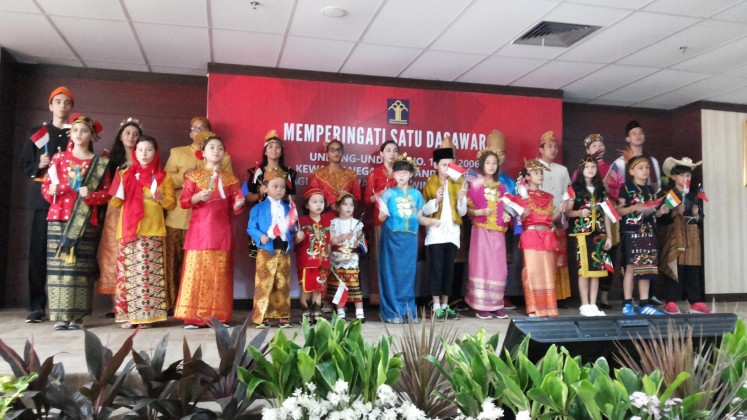Handling sacred kris
Alive with movement: Kris hilts are made from rare woods, bone and precious metals
Change Size
 Alive with movement: Kris hilts are made from rare woods, bone and precious metals. The finest Balinese hilts appear to be dancing.(JP/JB Djwan) (JP/JB Djwan)
Alive with movement: Kris hilts are made from rare woods, bone and precious metals. The finest Balinese hilts appear to be dancing.(JP/JB Djwan) (JP/JB Djwan)
A
span class="inline inline-center">Alive with movement: Kris hilts are made from rare woods, bone and precious metals. The finest Balinese hilts appear to be dancing.(JP/JB Djwan)
King of pigs Beda Hulu leans to the left in his dance. The Balinese leader carries his scepter of office as his feet step through the ritual movements dictated eons ago. He has been dancing forever, his form captured in a miniature carving that is the hilt of a sacred kris.
Master craftsman, Ida Bagus Puja has spent the past three weeks carving the 10-centimeter figure of Beda Hulu from moose bone he imports from Alaska. The skill the artist has honed over the past four decades is alive in the exquisitely proportioned fingers and toes of this highly refined sculpture. In the hand, Beda Hulu rests in perfect balance, like an extension of the bearer's arm.
'For the handle to be comfortable, the design is shaped first. When the hilt is comfortable I begin the carving,' says Puja who is from the bone carving village of Tampak Siring. At 23 years of age, his son Wahyu has begun his apprenticeship in the art form. 'I am still learning the finishing. I don't expect to carve a handle for at least 10 years,' says Wahyu of the training and practice required to craft the delicate bone kris handles.
The hilts of fine Balinese kris are far more than utilitarian handles as each has its own personality and should appear to dance, says Puja, who has brought the Beda Hulu hilt to a Bangli for finishing under the hands of silversmith Wayande, who believes Puja to be one of the masters of the hilt art form.
'You need to understand anatomy before you can begin to carve these kris handles. Balinese sculptures have character and the carver needs to feel that character before they begin to carve. Balinese kris hilts appear to be dancing, so it is good if the artist is also a dancer. They can bring the dance into the hilt,' says Wayande.
In his Bangli studio, Wayande will add the 'slot' to the hilt to fit the iron kris to the carving. Made of silver inlaid with precious stones these slots are also works of art that dress the kris.
'I add the stones, gold and silver to the hilts, like dressing the carved handles. I take naked handles and dress them before they are attached to kris blade. The process takes from one to two weeks. With a high quality piece like the moose bone Beda Hulu, I will add only the silver slot at the base. For hilts of wood I apply silver, gold and gems to the entire hilt,' said Wayande.

In Wayande's studio, dozens of fine kris line the walls, their wavy blades housed in scabbards of rare timbers and precious metals. The artistry surrounding kris is testament to the role these daggers have played in Balinese culture for centuries.
In the past kris were believed to be stores of magic that could ward off evil and break droughts.
'I have never seen kris magic, but I have heard of it from the old people. There are stories of people not being injured when stabbed by kris during trance dancing and other stories of the kris being the medium to the gods to bring rain,' says Wayande.
While the 42-year-old craftsman has never witnessed miracles brought about by kris, Wayande has seen people's confidence blossom through kris ownership.
'If you believe in the kris, it can give you confidence. If someone carries an ancestral kris they will feel more sure of themselves and safe. I think this is due to the ceremonies and prayers that are made before the kris is smithed,' says Wayande, adding he believes the patience and skill of the craftsmen given to the kris in its forming are tangible, particularly in the weapons that are handed down over generations.
'Kris in Bali are pusaka or heirlooms. They are sacred and in the old days every adult Balinese man had to have a kris. Just as they had to have a gemstone, a horse, a bird and a wife, at least for the higher caste Balinese men. These days the horse is replaced by motor bikes and the bird with hand phones,' quips Wayande.
Keris, with their elaborate hilts and scabbards, are still relevant to Balinese culture, with ancient kris stored in holy places of the home.
'Most families will have a kris, certainly in the past that was the case. But now some people sell these ancestral kris. I feel there is something missing when a family loses its kris. This is a Balinese characteristic, so the kris is important,' says Wayande, who with Puja and his son Wahyu, is keeping the keris tradition alive.









